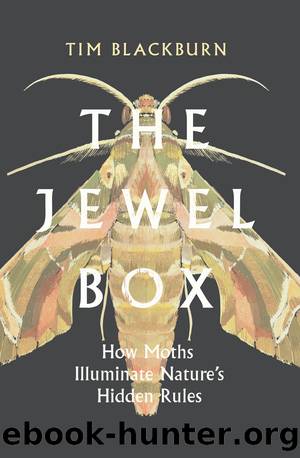The Jewel Box by Tim Blackburn

Author:Tim Blackburn [Blackburn, Tim]
Language: eng
Format: epub
ISBN: 9781642832747
Publisher: Island Press
Animals like the Silver Yâlong-distance migrantsâare an extreme expression of a feature fundamental to all life: the capacity to move. They are what we imagine when we think of migrationâanimals that undertake seasonal movements. They breed in one part of the world, and then, because conditions become unfavorable in the breeding grounds for some of the year, they move (migrate) to another area to wait for those conditions to improve. In the northern hemisphere, migrants head south for the winter and then return in the spring. Some fly from the Arctic to the Antarctic and back every year. Their reappearance is long anticipated and a welcome harbinger of the good times of summer. In other parts of the world, these migrants may be moving south in the summer, or up and down mountains, or between wet and dry areas. In all cases, though, these migrations are more or less predictable seasonal movements, generally of entire populations, to avoid times of hardship. Or perhaps more accuratelyâbecause most groups of plants and animals originated in the tropicsâto exploit times of abundance.i
To an ecologist, though, migrants can be individuals with much more modest ambitions. Migration can describe the daily behavior of animals and plants. Planktonic animals like copepods (tiny pelagic crustaceans) move up and down in the water column, for example. They rise to the surface at night and sink down to lower depths in the daytime, perhaps to avoid diurnal predators or damaging solar rays. Larger animals migrate up and down the seashore with the tide.
We also use the term migrant to reference an individual that moves in and out of a populationâprefixing with e- or im- to clarify the direction of travel. Most species have different populations, and these populations will by definition be connected by migration. Populations that do not exchange individualsâand therefore genesâwith any other populations are reproductively isolated, and they present a case for being considered separate species.ii At least they may be on their way to becoming separate. Migration between populations is thus important for both ecology and evolution.
Movement within populationsâdispersalâmatters too, of course. The movement of individuals from their place of birth to a new spot to breed, for example, or from one breeding location to another. It helps in the shuffling of genes. Sometimes, dispersal takes an individual from one population to another.
The ability to move is fundamental to the persistence of all life. Without movement, individuals would not have new resources to exploit. Populations would not be able to grow. Communities would not diversify. Land would be barren. Even organisms that we consider to be staticâbarnacles, corals, and lichens, for exampleâall have the means to travel. Itâs easy to think of plants as rooted to the spot, but of course they canâand mustâmove at some point. Indeed, they have a life stage to which movement is integral. A seed that falls in the shadow of its parent tree will be starved of light, water, and nutrients. It will be prey to the same herbivores and diseases that its parent attracts.
Download
This site does not store any files on its server. We only index and link to content provided by other sites. Please contact the content providers to delete copyright contents if any and email us, we'll remove relevant links or contents immediately.
Sapiens: A Brief History of Humankind by Yuval Noah Harari(13149)
The Tidewater Tales by John Barth(12058)
Do No Harm Stories of Life, Death and Brain Surgery by Henry Marsh(6362)
Mastermind: How to Think Like Sherlock Holmes by Maria Konnikova(6294)
The Thirst by Nesbo Jo(5835)
Why We Sleep: Unlocking the Power of Sleep and Dreams by Matthew Walker(5699)
Sapiens by Yuval Noah Harari(4600)
Life 3.0: Being Human in the Age of Artificial Intelligence by Tegmark Max(4555)
The Longevity Diet by Valter Longo(4480)
The Rules Do Not Apply by Ariel Levy(3949)
The Body: A Guide for Occupants by Bill Bryson(3883)
The Immortal Life of Henrietta Lacks by Rebecca Skloot(3859)
Why We Sleep by Matthew Walker(3812)
Animal Frequency by Melissa Alvarez(3783)
Yoga Anatomy by Kaminoff Leslie(3736)
Barron's AP Biology by Goldberg M.S. Deborah T(3654)
The Hacking of the American Mind by Robert H. Lustig(3616)
All Creatures Great and Small by James Herriot(3556)
Yoga Anatomy by Leslie Kaminoff & Amy Matthews(3433)
